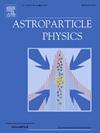Candidate detection of GRB221009A by Yangbajing muon telescope
IF 2.9
3区 物理与天体物理
Q1 ASTRONOMY & ASTROPHYSICS
引用次数: 0
Abstract
Long gamma-ray bursts (GRBs) can be generated by the collapse of a rapidly rotating massive star into a black hole and are the brightest known explosive events in the Universe. GRB221009A is the most energetic gamma-ray burst ever recorded, providing delayed detection of very high energy photons that challenge the standard propagation mechanisms, possibly suggesting exotic physics phenomena. An excess, synchronous with the ignition of GRB221009A, is detected in the rate of the Yangbajing muon telescope. A preliminary assessment of the significance of this excess limits the probability of a chance coincidence to less than 10−3. The hypothetical mechanisms for producing a muon excess induced by the GRB are exotic/puzzling. If confirmed by further investigations, this excess would add another feature to the many anomalies observed in this extreme astrophysical event.
羊八井μ介子望远镜对 GRB221009A 的候选探测
长伽马射线暴(GRB)可由快速旋转的大质量恒星坍缩成黑洞产生,是宇宙中已知最亮的爆炸事件。GRB221009A 是有记录以来能量最大的伽马射线暴,它提供了对高能光子的延迟探测,挑战了标准的传播机制,可能暗示了奇异的物理现象。扬巴叮μ介子望远镜的速率检测到了与GRB221009A点火同步的过量。对这一过量的重要性进行的初步评估将偶然巧合的概率限制在 10-3 以下。GRB诱发μ介子过量的假设机制非常奇特/令人费解。如果得到进一步研究的证实,这一过量将为在这一极端天体物理事件中观测到的许多异常现象增添新的特征。
本文章由计算机程序翻译,如有差异,请以英文原文为准。
求助全文
约1分钟内获得全文
求助全文
来源期刊

Astroparticle Physics
地学天文-天文与天体物理
CiteScore
8.00
自引率
2.90%
发文量
41
审稿时长
79 days
期刊介绍:
Astroparticle Physics publishes experimental and theoretical research papers in the interacting fields of Cosmic Ray Physics, Astronomy and Astrophysics, Cosmology and Particle Physics focusing on new developments in the following areas: High-energy cosmic-ray physics and astrophysics; Particle cosmology; Particle astrophysics; Related astrophysics: supernova, AGN, cosmic abundances, dark matter etc.; Gravitational waves; High-energy, VHE and UHE gamma-ray astronomy; High- and low-energy neutrino astronomy; Instrumentation and detector developments related to the above-mentioned fields.
 求助内容:
求助内容: 应助结果提醒方式:
应助结果提醒方式:


